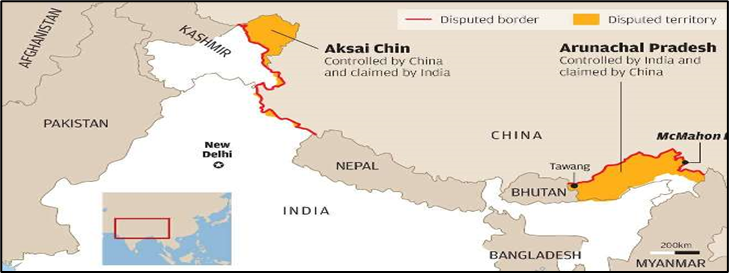In News:
- Indian and Chinese army troops clashed along the Line of Actual Control (LAC) in the Tawang Sector of Arunachal Pradesh on December 9.
- The clash in the LAC's eastern sector, that includes Sikkim and Arunachal Pradesh, comes when tensions in the northern sector of Ladakh are yet to be fully resolved.
What’s in Today’s Article:
- Eastern Sector of LAC – Background, Border dispute in eastern sector (McMahon line, recent activities of China in this sector, Indian steps etc.)
- News Summary
In Focus: Eastern Sector of LAC

Background: Sino – India Border Dispute
- The territorial dispute along the China-India border falls across three different areas:
- The eastern sector, about 90,000 square kilometers, corresponds roughly to the Indian state of Arunachal Pradesh and is under Indian control.
- The western sector, sometimes called Aksai Chin or part of Ladakh, involves about 33,000 square kilometers and several districts in Xinjiang.
- It is under Chinese control.
- The central or middle sector, west of Nepal, is the smallest contested area, around 2,000 square kilometers, and control is divided.
- In 1993, after years of territorial standoffs and negotiations, China and India finally signed an agreement which attempted to mark out a long stretch of border between the two countries.
- That border is known as the line of actual control (LAC), but its precise location can be blurry, and there is still dispute between China and India
- So far, this LAC has served as the de facto border between these two countries.
- However, in at least 13 places, the two sides disagree over where the LAC lies.
Border Dispute in Eastern Sector: McMahon Line
- The disputed boundary in the Eastern Sector of the India-China border is over the McMahon Line.
- Representatives of China, India and Tibet in 1913-14 met in Shimla to settle the boundary between Tibet and India, and Tibet and China.
- During the Shimla conference, Sir Henry McMahon, the then foreign secretary of British India, drew up the 550 miles (890 km) McMahon Line as the border between British India and Tibet.
- The McMahon line moved British control substantially northwards. This agreement ceded Tawang and other Tibetan areas to the imperial British Empire.
- Though the Chinese representatives at the meeting initialled the agreement, they subsequently refused to accept it.
- Subsequently, the Chinese government stated that it does not recognize the "illegal" McMahon Line.
- China accuses India of occupying areas in Arunachal, which it calls part of Southern Tibet.
Recent activities of China in eastern sector
- It has deployed a high number of reserve troops along the LAC in the Eastern Command.
- It has also ramped up integrated military exercises. It is conducting annual training exercises of longer duration in depth areas.
- It continues to construct dual-use border villages and troop habitats which can be used by both military and civilians.
- There has been a marginal increase in patrolling activities in some areas along the LAC.
Steps taken by India to counter China in this region
- India strengthening its vulnerabilities
- It is working towards mitigating the threat to the vulnerable Chicken’s Neck area.
- Chicken’s Neck area or the Siliguri Corridor is the narrow strip of land that connect the North-east with rest of India.
- India has also maximised the use of for ISR (intelligence, surveillance and reconnaissance).
- New aviation brigade in the eastern sector
- India raised a new aviation brigade in the eastern sector this year.
- It was raised in March at Missamari in Assam, close to Tezpur.
- The brigade is mandated with the task of increasing surveillance along the LAC in the eastern sector.
- Other measures taken by India
- India has based the second Rafale fighter squadron in Hasimara (close to the Sikkim-Bhutan-Tibet tri-junction)
- Sukhoi-30MKI jets are already deployed at air bases like Tezpur and Chabua
- Akash surface-to-air missile systems along with Bofors howitzers have been deployed.
News Summary










